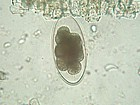Sheep Nematodes Overview
Introduction
The important nematode infections of sheep are mostly refined to the gastrointestinal system. Clinical problems are more commonly seen in lambs than in adult sheep, though this varies with they type of nematode. They can cause substantial economic loss both in mortality and in reduced growth rate of lambs.
Gastrointestinal Nematodes
Many worm species occur in the gastrointestinal tract of sheep, though relatively few are of importance in the UK. Primary pathogens include:
| Abomasum | Small Intestine | Large Intestine | |
|---|---|---|---|
| Primary Pathogens in the UK |
|
||
| Worms that contribute to ovine PGE, but are rarely primary pathogens in the UK |
|
|
- All the above worms belong to the Trichotrongyloidea except:
- Bunostomum (a hookworm)
- Oesophagostomum
- Chabertia (Strongyloidea)
- Strongyloides (Rhabditoidea)
- Trichuris (a whipworm)
- Although many different genera and species of worms may be found in the gastro-intestinal tract of sheep there are only three distinct disease manifestations within the PGE complex:
- Ostertagiosis and Trichostrongylosis
- Nematodirosis
- Haemonchosis
Succession of Gastrointestinal Worm Species
The relative number of worms of each species changes during the grazing season. The succession of species is due to differences in:
- Ability of L3 to overwinter
- Fecundity between worm species
- Rate of development from egg to L3 stage
- Special requirements of Nematodirus
